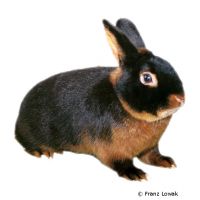Tan Rabbit (Oryctolagus cuniculus f. dom. 'Tan')
| Tan Rabbit Oryctolagus cuniculus f. dom. 'Tan' | |
|---|---|
| Name | Tan Rabbit |
| Name Lat. | Oryctolagus cuniculus f. dom. 'Tan' |
| Family | Hares & Rabbits |
| Family lat. | Leporidae |
| Order | Lagomorphs |
| Order lat. | Lagomorpha |
| Origin | Europe (breeding variety) |
| Climate | Temperate |
| Habitat | Grassland, forest |
| Diet | Hay, veggies, herbs |
| Behavior | ♂ semi-aggressive |
| Keeping | Pair, group |
| Care Level | Easy |
| Life Span | 5-10 years |
| Protection | No |
| Metric Units | |
| Size | Up to 3 kg |
| Temperature | Room temperature |
| Housing | 150 x 60 x 50 cm |
| US Units | |
| Size | Up to 6 lb |
| Temperature | Room temperature |
| Housing | 60" x 25" x 20" |
Distribution and habitat
The dwarf rabbit Lohfarben is a breeding form of the European wild rabbit, whose original home was the Iberian Peninsula. At the beginning of the 20th century, people started to breed smaller breeds and keep them as pets. Today, different breeds and colors are bred
Cage size
The cage size should be at least L 150 x W 60 x H 50 cm for one pair. For each additional animal, the floor space should be increased by 20%. The cage should be placed in a bright (no direct sunlight), draught-free and quiet place and have cross-wiring, with a grid width that excludes injuries. Terrariums or aquariums are unsuitable for keeping.
Maintenance
The basic equipment includes a hay rack, which is covered at the top or attached to the outside of the cage to prevent injuries, a house with a flat roof and at least two entrances for each animal, food and drinking containers (drinking bottles) and a rabbit toilet. Commercially available small animal litter, hemp litter, fine beech granules or linseed litter is suitable as a substrate. The litter depth should be 2-5 cm. Mineral cat litter is not suitable. Nail material (rodent stones, wood) must always be available to wear down their permanently regrowing teeth. They should be kept at room temperature and their natural day-night rhythm should be respected.
Diet
They are herbivores and their basic food is hay, which should always be available in the best quality in the hay rack. In addition, they need vegetables (e.g. carrots, fennel, broccoli, celery, dandelion, grasses), some fruit (apples) and minerals (rodent stone, salt lick), supplemented with "rabbit food" available in specialized stores. Young animals should be carefully accustomed to the green food only with small amounts (danger of diarrhea). Water must always be available in hanging bottles or in stable, open containers and, like food, should be offered daily. Water and food containers must be arranged so that they cannot become soiled. Hard bread is not suitable as nail material.
A varied diet promotes health and prevents deficiency symptoms.
Behaviour and compatibility
Pygmy rabbits have a strong need for social contact with conspecifics. They should be kept only in pairs, excluding incompatible animals, or in a group, such as a (neutered) buck with several females or an all-female group. Neutered males are usually more compatible. At the first sign of incompatibility, separate the animals immediately. Socialization of guinea pigs and rabbits is not recommended due to differences in behavior.
Reproduction and breeding
If you stretch the skin between the anus and the genital opening, you can see the sexual organ in males. Pregnant females must be provided with an additional nest chamber with a floor area of 1,000 cm² (e.g. 25 x 40 cm) and a height of 25 cm with suitable nesting material at least one week before the due date, the gestation period is 28-33 days. A litter usually consists of 2-12 young, which are born naked, blind and deaf. After about 2 weeks the eyes open. The young nurse for 4-6 weeks and can be separated from their mother after 10 weeks. At the age of 3-7 months they are sexually mature, ready for breeding after 6-8 months
A female may have 3-8 litters per year. The life expectancy is 5-10 years.
Important
Cages should only be placed outdoors (e.g. on balconies) with the animals for a short time. They must be protected from harmful weather conditions, such as direct sunlight or rain. Eating droppings in rabbits is not a behavioral disorder, but serves to provide them with vitamin B. As escape animals, they need sufficient retreat and hiding places, so the cage should also be somewhat elevated and not placed on the floor. Special attention should be paid to thorough hygiene and impurities should be removed regularly.
Further literature can be found in your pet store.
References
Text: petdata; Image: Franz Lowak
Source: BMEL (2014): Gutachten über Mindestanforderungen an die Haltung von Säugetieren; W. PUSCHMANN, D. ZSCHEILE, K. ZSCHEILE (2009): Zootierhaltung - Tiere in menschlicher Obhut: Säugetiere, Harri Deutsch Verlag; DREYER: Mein Zwergkaninchen zu Hause, bede Verlag
- Gemäß § 21 Abs. 5 Tierschutzgesetz idgF
